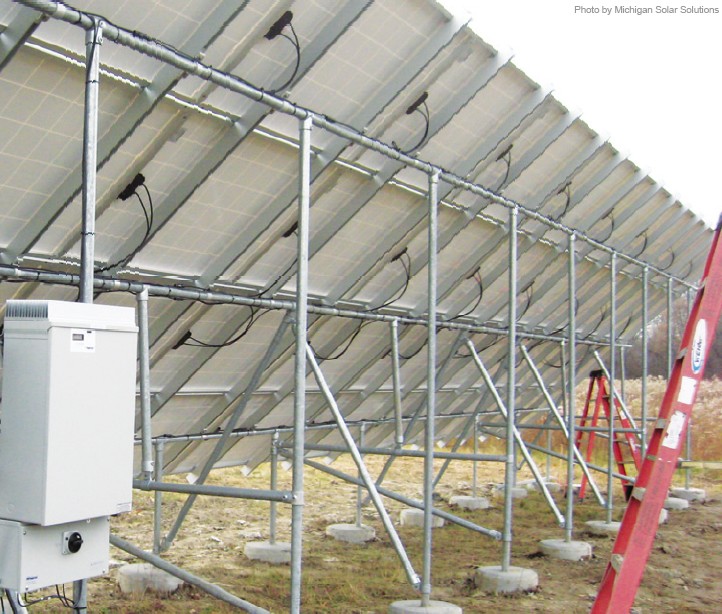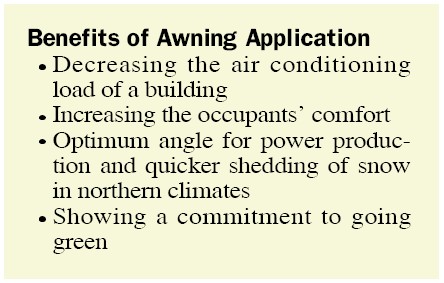The U.S.A. has experienced a tough couple of years, especially in the Midwest. PV industry has not escaped unscathed. However, it is showing signs of growth in regions with colder climates in the U.S.A.

BY Mark Hagerty
Signs of Growth
It has been a tough couple of years for manufacturing companies of all types throughout the U.S.A., especially in the Midwest. Factory doors are being closed and gates locked at an alarming pace. The companies that are lucky enough to stay afloat have reduced their workforce, cut pay and made other drastic changes just to stay open.
Photovoltaic manufacturers, distributors, system integrators and others throughout the alternative energy industry have not escaped unscathed. However, the alternative energy industry throughout the country, particularly in the Midwest and in states such as Michigan, is showing signs of growth.
Going Solar
The steady growth coupled with signs that the economy is slowly showing signs of improvement last few months have many experts predicting that 2010 could be the year for many businesses to consider going solar.
There are lots of reasons for this: One is for the greening of the environment. The other is for the green of money. With recently-enacted incentives, rising energy costs, increasing capacity for manufacturing solar panels and the balance of system components, renewable energy has never been cheaper.
Misconception vs. Reality
There is a misconception among customers that the warmer, sunnier states such as Florida, California and those throughout the Southwest are more conducive to solar electricity. Not known for sunshine or warm weather, Michigan and other Midwestern states may not seem like the most efficient place for harnessing solar energy.
In reality, Michigan has an average of 4.2 hours of peak sunlight per day each year. Florida, the “Sunshine State” only has a little over five hours. Interestingly, Germany leads the world in the percentage of electricity generated by solar, but has less than four hours of peak sunlight a day. Peak sunlight is defined as sun intense enough that it delivers 1,000 W per square meter. What most people don’t add to the equation is the heat factor. Solar panels are less efficient the hotter they get and actually produce more power when it gets cooler. While parts of the south may get more hours of sun, the panels produce less voltage per peak hour because of the heat.
Cooling System for Efficiency
An example of the relationship between heat and electronics can be found in computer rooms. These rooms have sophisticated climate control systems. Companies will spend thousands of dollars annually to keep these rooms cool. Why? Because it will allow their equipment to operate at its best efficiency and extend its life.
Another example of the relationship between heat and electronics can be found when a solar electric system designer develops a system. The size of the conductors must be increased to accommodate the increased power that will be generated at the lowest possible temperature for a region. In Southern Michigan, -20 degrees F is used when sizing the conductors. With two identical systems, one in a southern state and one in a northern state, the northern state MUST have larger conductors to meet code.
Best Condition for PV
Knowing that a cool environment, with a lot of sun, has to be the best situation for solar electric production, then one of the best climates would be in the mountains. In that climate, cloud cover is rare at that higher altitude and the weather is cold enough to keep the panels at their peak efficiency.
With the addition of bifacial panels to the market place, these regions have another advantage. The sunlight reflected by the snow-covered ground can be used to generate even more power. Applications like car ports, pavilions, and covered porches can generate much more power with these panels. The time is fast approaching that all panel manufacturers will soon have bifacial panels and when that happens, the price will come down substantially.

Halle 8.6 kW ground mount array
Awning Application
Using photovoltaic panels in passive solar applications like awnings, will also help keep the panels cooler. In this application, they do not receive the radiated heat from the roof of the building. This helps prevent a substantial decrease to the energy harvest of a panel over its lifetime.
Added benefits to an awning application are:
● Decreasing the air conditioning load of a building by shading the summer sun while still allowing the lower winter sun.
● Increasing the occupants’ comfort.
● The ability to mount the panels at the optimum angle for power production, and for allowing quicker shedding of snow in northern climates.
● For businesses, it is a beacon showing their commitment to going green.
Incentives for Going Green
The U.S. Federal Government is helping make “Going Green” more attractive to business owners and homeowners alike.
Tax Credit and Deduction
As a result of the economic downturn, the U.S. Federal Government is now allowing businesses to use a 30% grant from the U.S. Treasury Department to invest in renewable energy. Residential customers still have the 30% Federal Tax Credit. Many people do not understand the difference between a tax credit and a tax deduction. A tax credit reduces the amount you owe the government. A tax deduction reduces the amount of your adjusted gross income.
Net Metering Laws
Additionally, most states now have true Net Metering Laws. True Net Metering is when the utility companies have to accept, at full retail value, any electricity that an owner puts onto the grid. This allows homeowners to “store” extra electricity on the power grid. With true Net Metering, homeowners do not need batteries to have a zero energy bill. Seasonal businesses can produce power all during their off season, building credits for when they need it.
Green Initiatives
Many suppliers are being pressured by their customers to start a green initiative. Companies such as Walmart are having their suppliers either purchase PV for their business or buy Solar Renewable Energy Credits (SREC’s). This allows many potential PV purchasers to sell their SREC’s to a broker. When a solar power system generates 1,000 kilowatt hours of power, the owner earns one SREC. This SREC can then be sold to companies, utilities, or individuals while the producer uses the power.
Even utility companies are offering incentives. In southeast Michigan, DTE Energy is one example. They have a mandate to supply 10% of their energy from renewable sources by 2015. As a result, DTE is currently piloting a “Solar Currents” program designed to make solar energy more affordable. It has been authorized by the Michigan Public Service Commission to partially reimburse customers for installing solar systems on their homes or businesses.
“Solar Currents” will pay US$2.40 a watt within 60 days of commissioning the system. After it has been installed, customers who participate in the program will receive a credit on their energy bills for the next 20 years (11 cents per kilowatt hour) for all the electricity they produced, even if they consume 100% of it! This is in addition to federal tax credits and other local incentives.
Consumer’s Energy in Michigan has also introduced a feed-in tariff to spur more interest in solar. Their program reimburses customers 65.0 cents per kilowatt hour, for approved systems installed by May of 2010, (52.5 cents per kilowatt hour for approved systems installed after May of 2010) for any electricity customers produce from solar-powered systems. Similar programs in Germany have resulted in the creation of 170,000 jobs and the most solar-powered systems installed per capita in the world.

Commitment to Going Green
The marketing value of a solar array is hard to quantify for business owners and is often underestimated. However, customer feedback shows that a significant portion of the population will redirect a purchase to a business that has demonstrated a commitment to going green. For example:
● Hybrid cars are not to the point where their purchase can be justified on solid financial alone. The purchaser is making a statement. The average Prius owner could have afforded a much more prestigious vehicle.
● DTE Energy has a program called “Green Currents” which allows customers to sign up to pay an extra couple of cents per
kWh with the proceeds used for greening initiatives.
Businesses with an environmental conscience already understand that renewable energy like solar can make a big impact on the environment. At the same time, it cuts down the use of non-renewable resources such as oil, coal and gas.
Businesses that might not ordinarily be concerned about the environment are taking an interest due to increasing requirements to go green, additional government taxes and incentives, and the security of the U.S.A.
Electricity Issue
In the U.S.A., the electrical power grid is the Achilles Heel. Recent reports have shown that something as simple as a cyber attack on the distribution grid could knock it out for several weeks. From a national defense standpoint, distributed power generation is the safest system available.
The U.S.A. hundreds of billions of dollars every year foreign countries oil. Becoming energy independent help balance the trade and strengthen the dollar.
In a June 30, 2008 article in Forbes Magazine titled “Brownout” by Mark P. Willis, it states, “what happens when you don’t build more power plants? Get ready for spiking electric rates, brownouts and even blackouts. If you think runaway oil prices are upsetting, just wait for what’s in store for electricity.” This problem is multiplied by people replacing their TVs with plasma TVs that take up to four times the energy. Once they buy the plasma TV, they need the home entertainment audio system. Just several short years ago when all appliances in a home were turned off, the electric meter would stop. Now with the phantom loads of charges, LCD displays and computers, a house is using power 24 hours a day.
The Bottom Line: What’s in It for Me?
Since electric rates are not a constant, it makes it difficult to precisely predict a Return on Investment (ROI) for customers choosing to go solar. Most experts agree that electricity rates are going up and will continue to increase steadily.
Residential and business customers going solar can conservatively expect an ROI within 7 to 10 years at the current rates. Factoring in an estimated inflation rate of electricity costs, it’s reasonable to expect to see an ROI within 7 years.
Mark Hagerty is President and Founder of Michigan Solar Solutions. Hagerty is passionate about solar power and excited about what the future holds for the industry (http://www.michigansolarsolutions.com/).
For more information, please send your e-mails to pved@infothe.com.
ⓒ www.interpv.net All rights reserved
|


